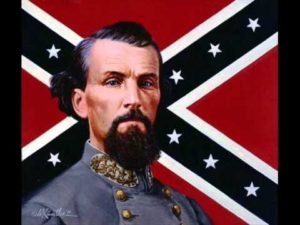Tom Roza on “Nathan Bedford Forrest – First with the Most”
 South Bay Civil War Roundtable Secretary Tom Roza provides an intriguing and detailed examination of the life and career of one of the most polarizing figures and greatest cavalrymen of the Civil War, Confederate general Nathan Bedford Forrest.
South Bay Civil War Roundtable Secretary Tom Roza provides an intriguing and detailed examination of the life and career of one of the most polarizing figures and greatest cavalrymen of the Civil War, Confederate general Nathan Bedford Forrest.
Born July 13, 1821, in Chapel Hill, Tennessee, along with a twin sister, Forrest had very little formal education, yet he is remembered as a self-educated, brutal, and innovative cavalry leader during the Civil War and as a leading Southern advocate in the postwar years. Before the Civil War, Forrest had already amassed a fortune as a planter, real estate investor, and slave trader. He was one of the few officers in either army to enlist as a private and be promoted to general officer and corps commander during the war. Although Forrest lacked formal military education, he had a gift for leadership, strategy, and tactics. He created and established new doctrines for mobile forces, earning the nickname The Wizard of the Saddle.
After the Civil War, Forrest and most Southerners railed against the Northern-implemented Reconstruction effort. He was a pledged delegate from Tennessee to the New York Democratic National Convention of July 1868. He served as the first Grand Wizard of the Ku Klux Klan, but later distanced himself from the organization.
Tom Roza’s main interest in the Civil War has focused on what type of people fought in the war as opposed to the actual battles. The presentation on Nathan Bedford Forrest follows in line with most of Tom’s presentations on John Buford, Winfield Scott Hancock, Jeb Stuart at Yellow Tavern, A.P. Hill, and Robert Gould Shaw. Tom also presented an in-depth two part presentation of Robert E. Lee’s first invasion of the north in September 1862, which culminated in the Battle of Antietam.
